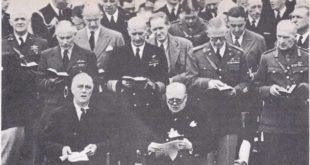AS THE SKY darkened over Moscow on the evening of March 5, 1953, thousands of people waited in line before a building called the Hall of Columns. Some of them wept; some carried flowers. Moving slowly and silently toward the entrance, they could see a forty-foot portrait of Premier Josef Stalin, framed in gold, which hung on the side of the building. News of Stalin’s death had been announced late that afternoon and now he lay in state in an immense room whose marble columns were draped in flags of red and black. Four days later, Stalin’s body was carried …
Read More »Tag Archives: General Dwight D. Eisenhower
Victory in Europe 1941 – 1945
Even before Pearl Harbour, there had been cooperation between the United States and Britain. In August of 1941, President Roosevelt and Prime Minister Churchill met secretly, on a cruiser at sea off the coast of Newfoundland. There they drew up the Atlantic Charter, a document stating the principles on which they based their hopes for a better future for the world. They pledged that neither country would seek more territory. They hoped that, “after the final destruction of Nazi tyranny,” all men in all lands could “live out their lives in freedom from want and fear,” and they called on …
Read More »
